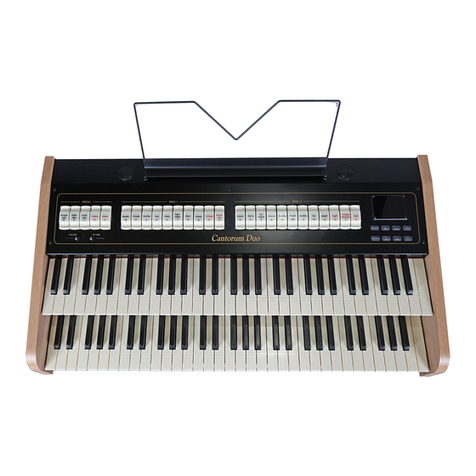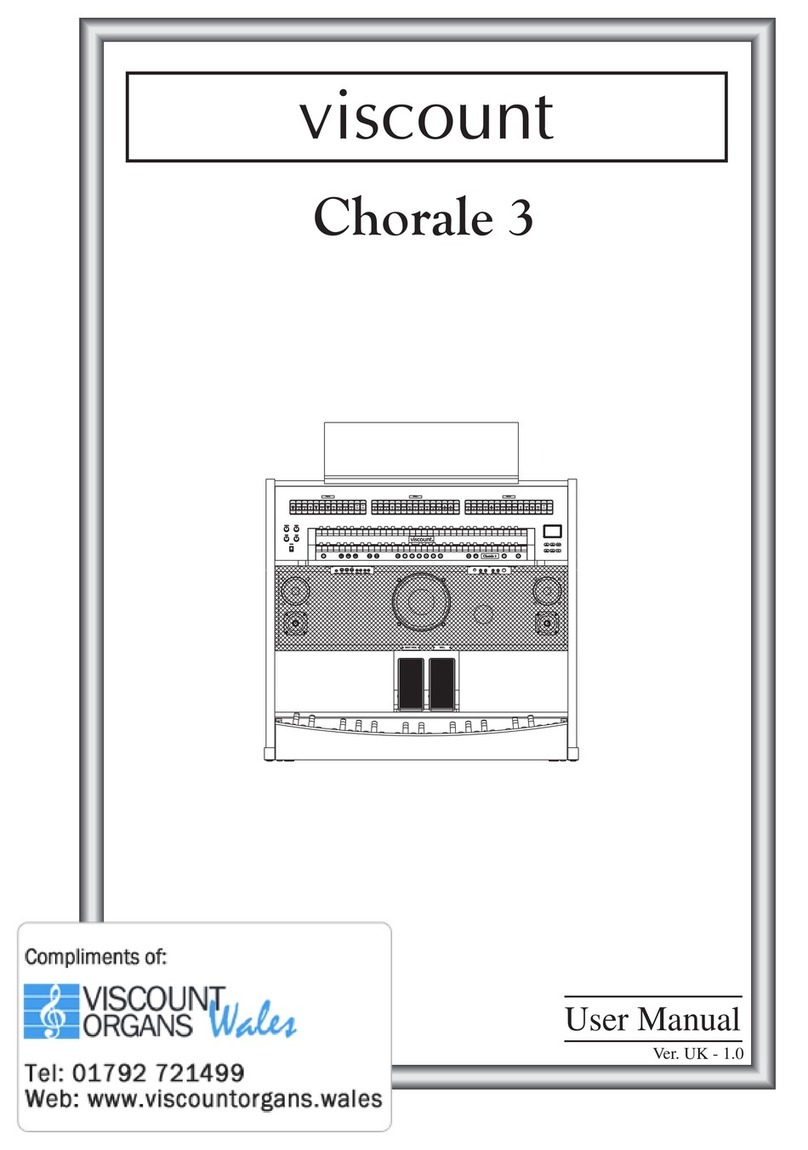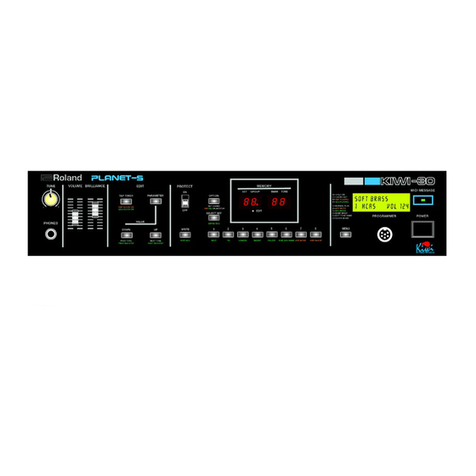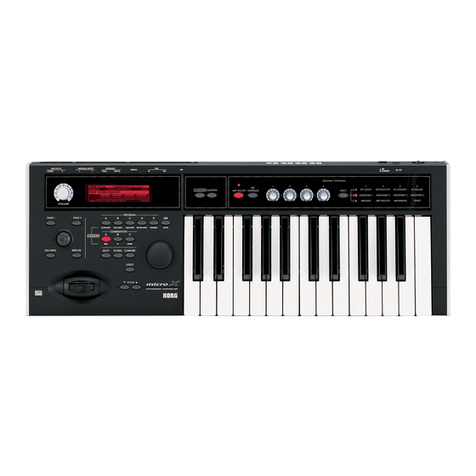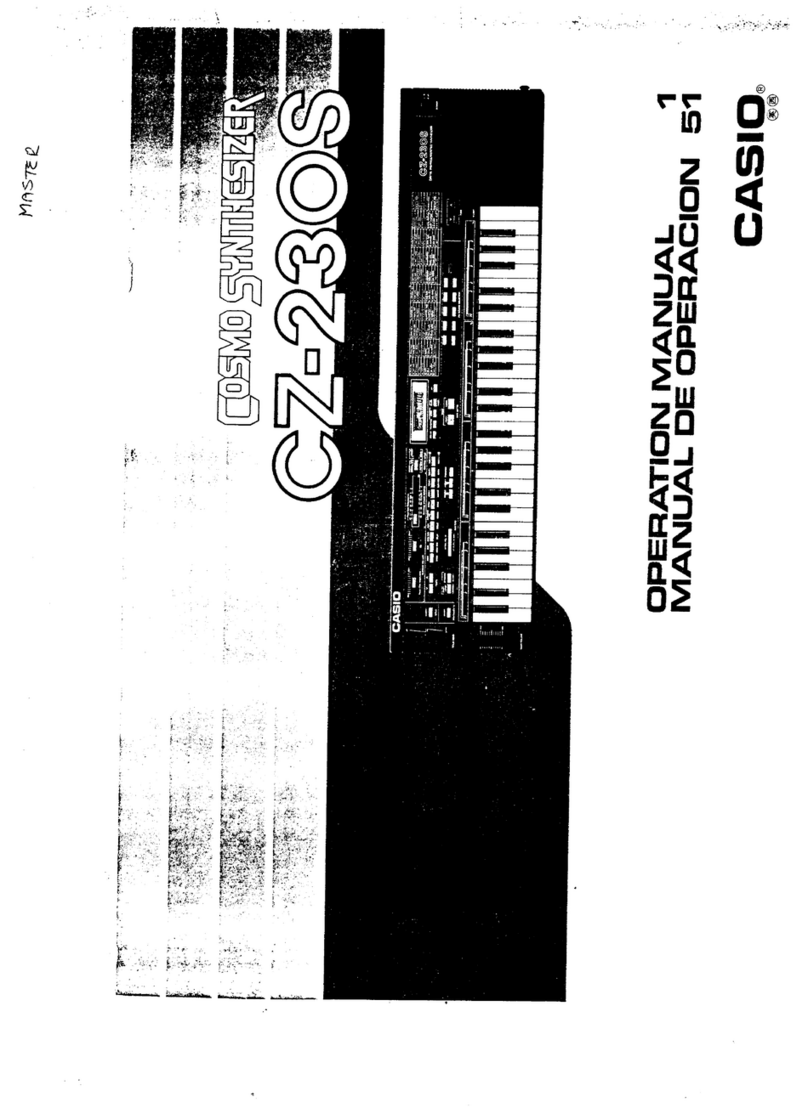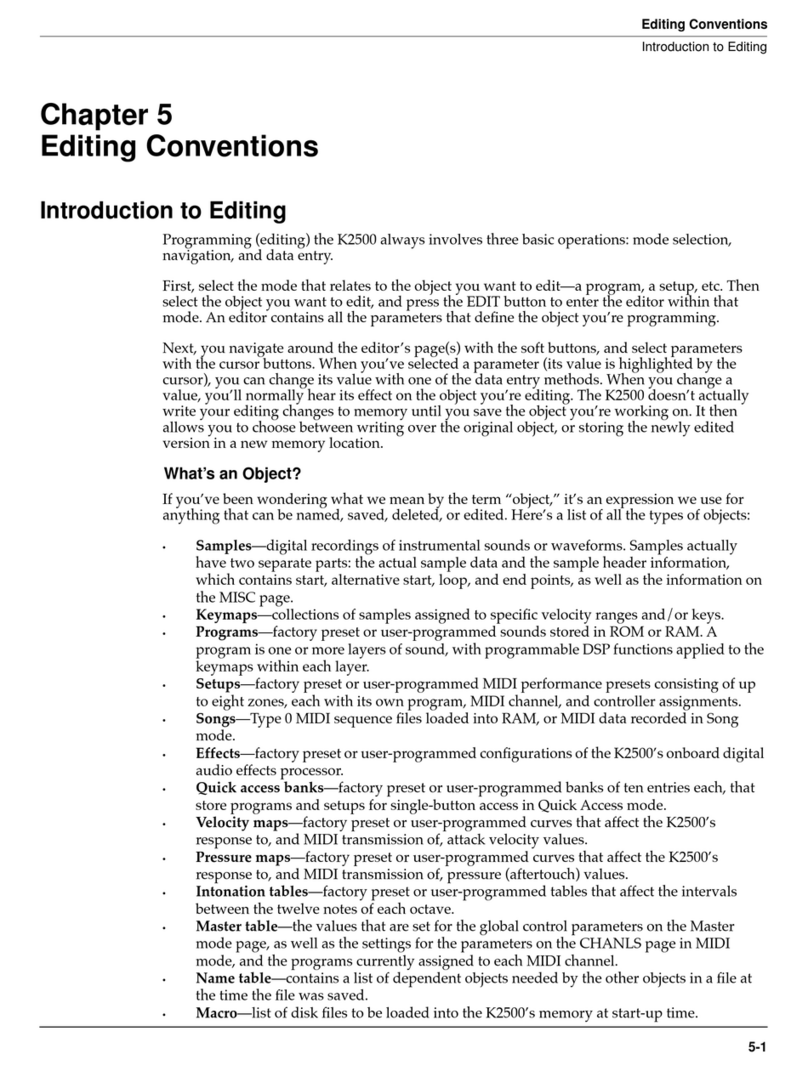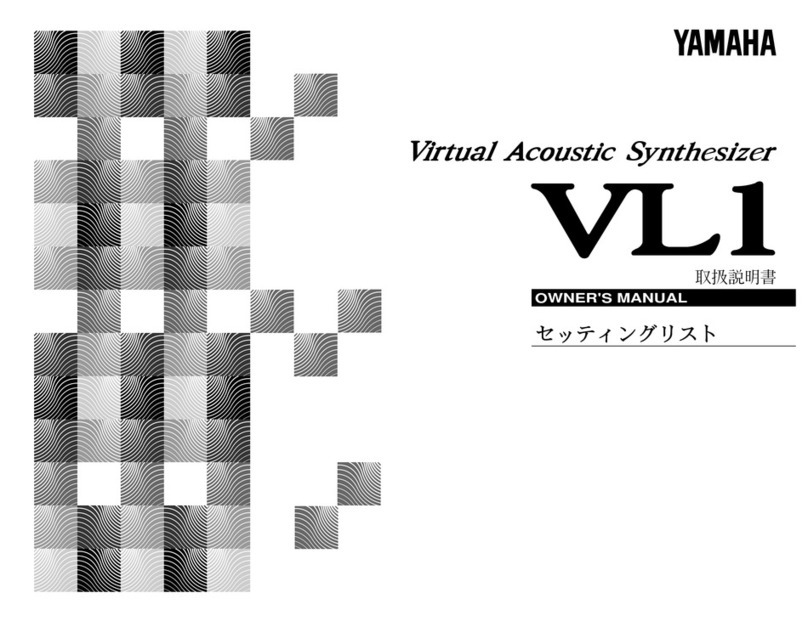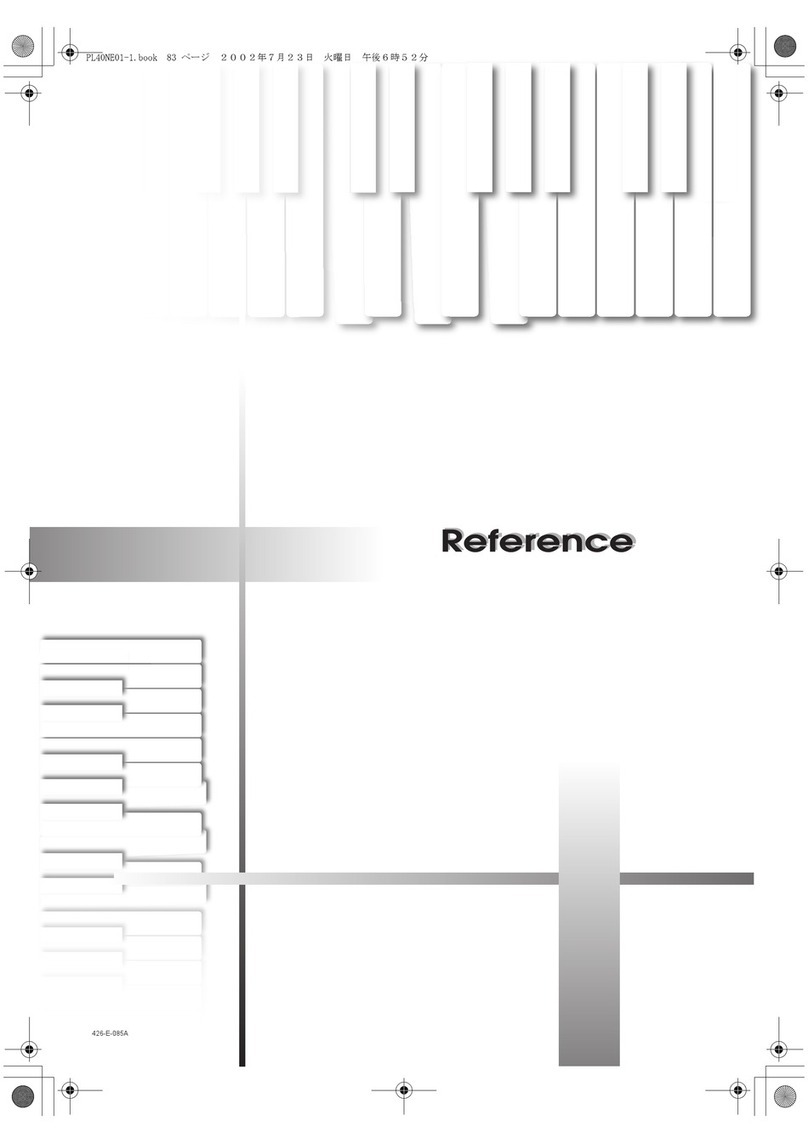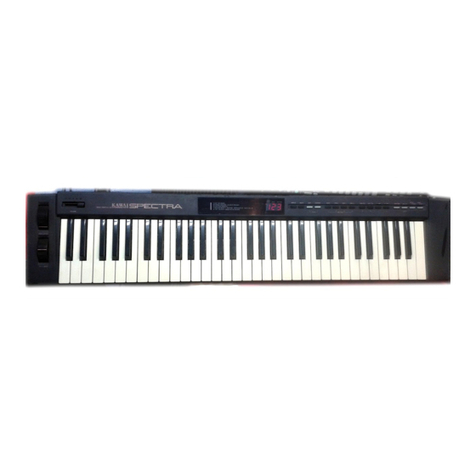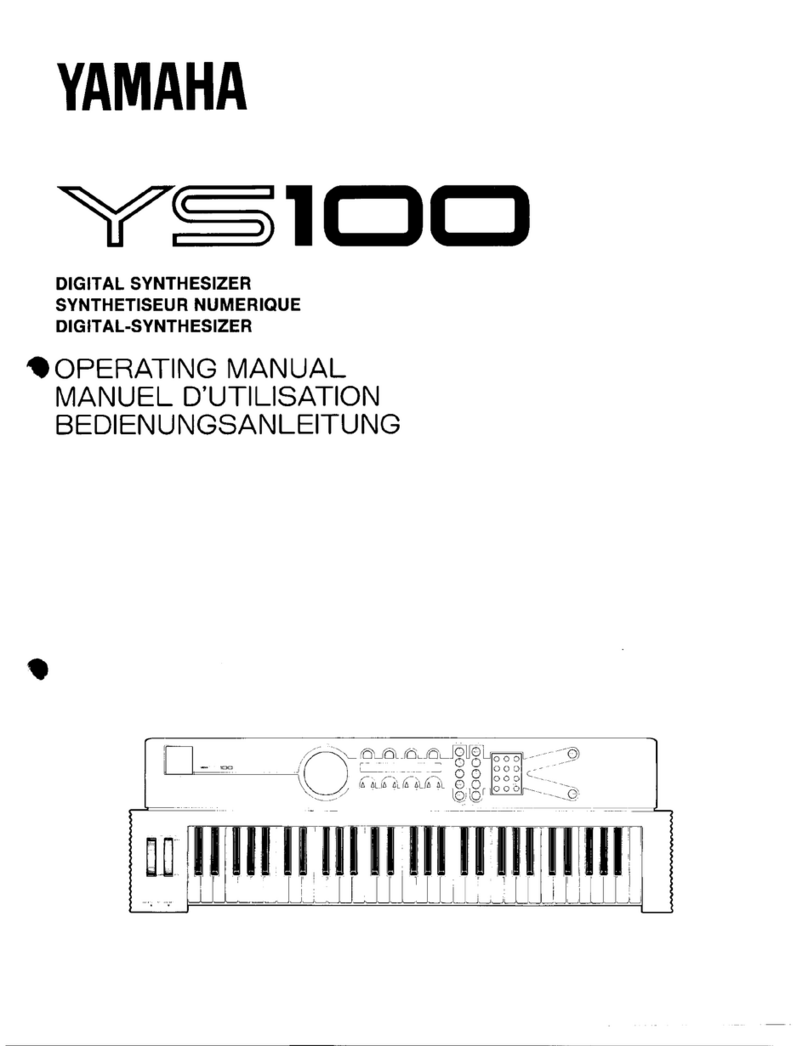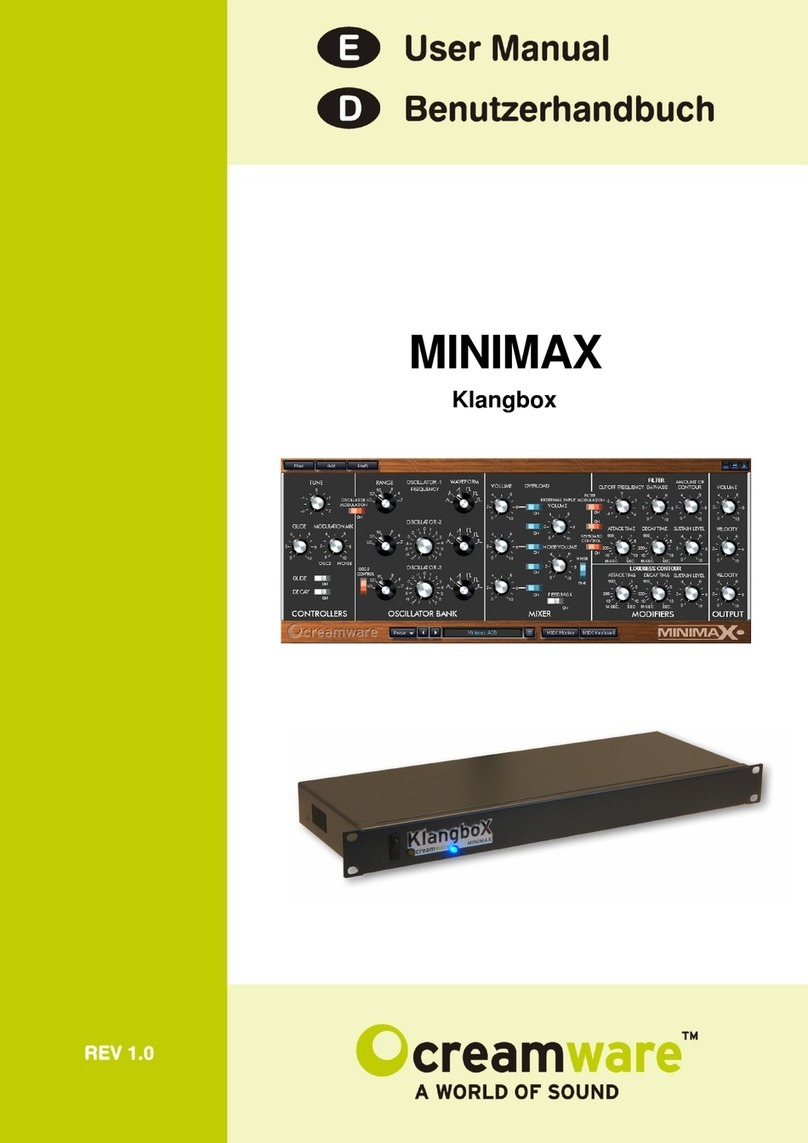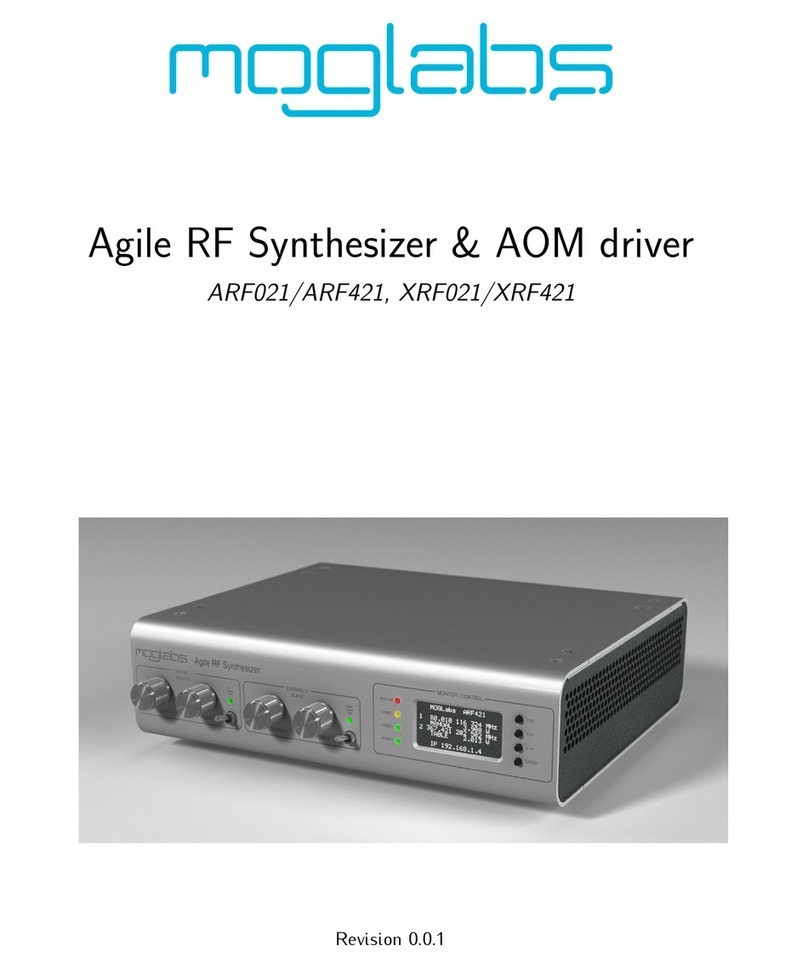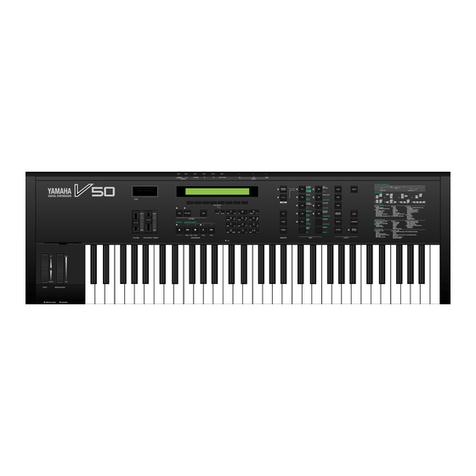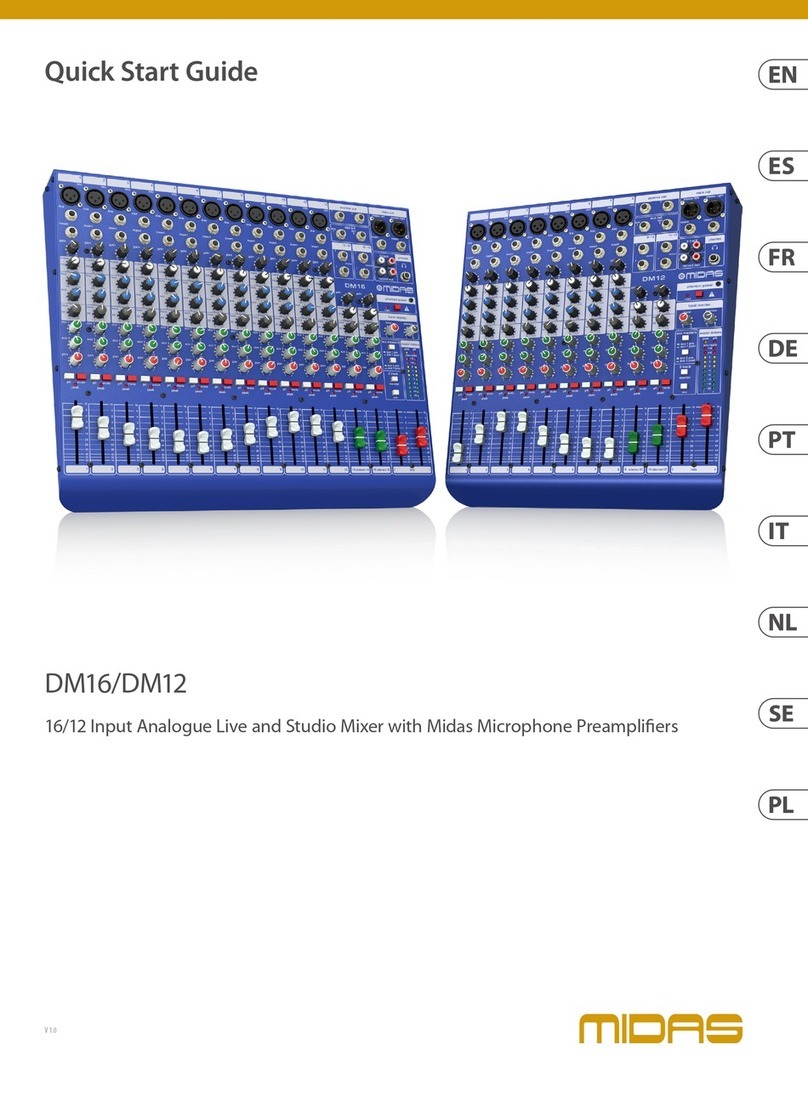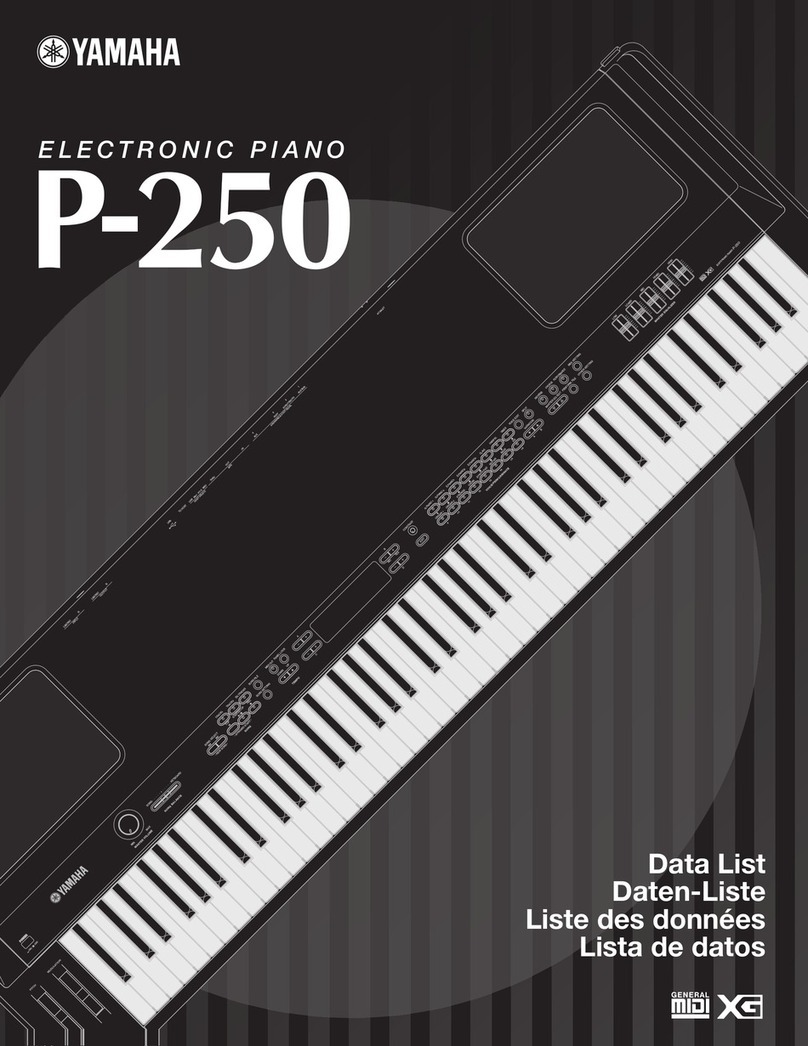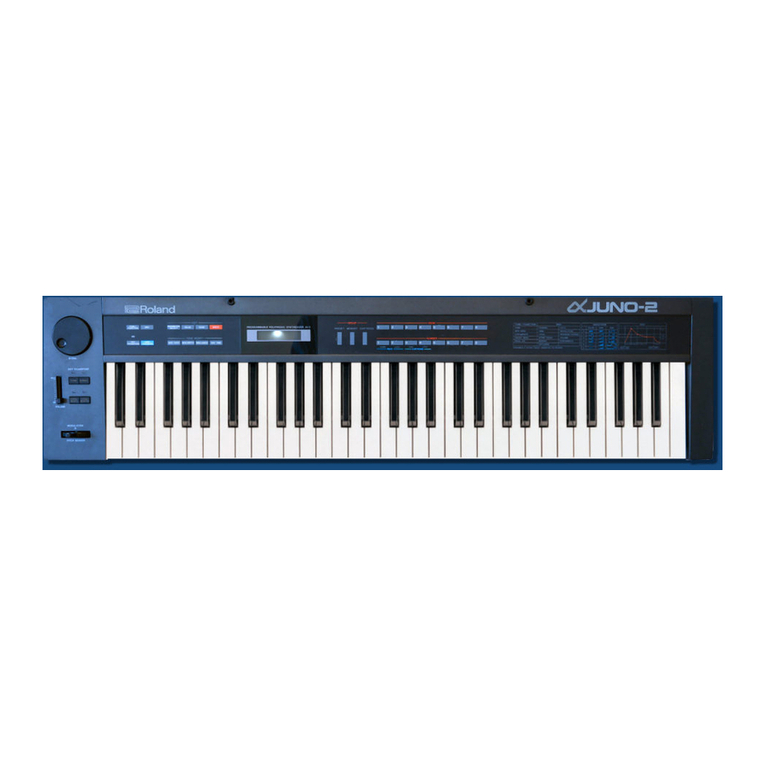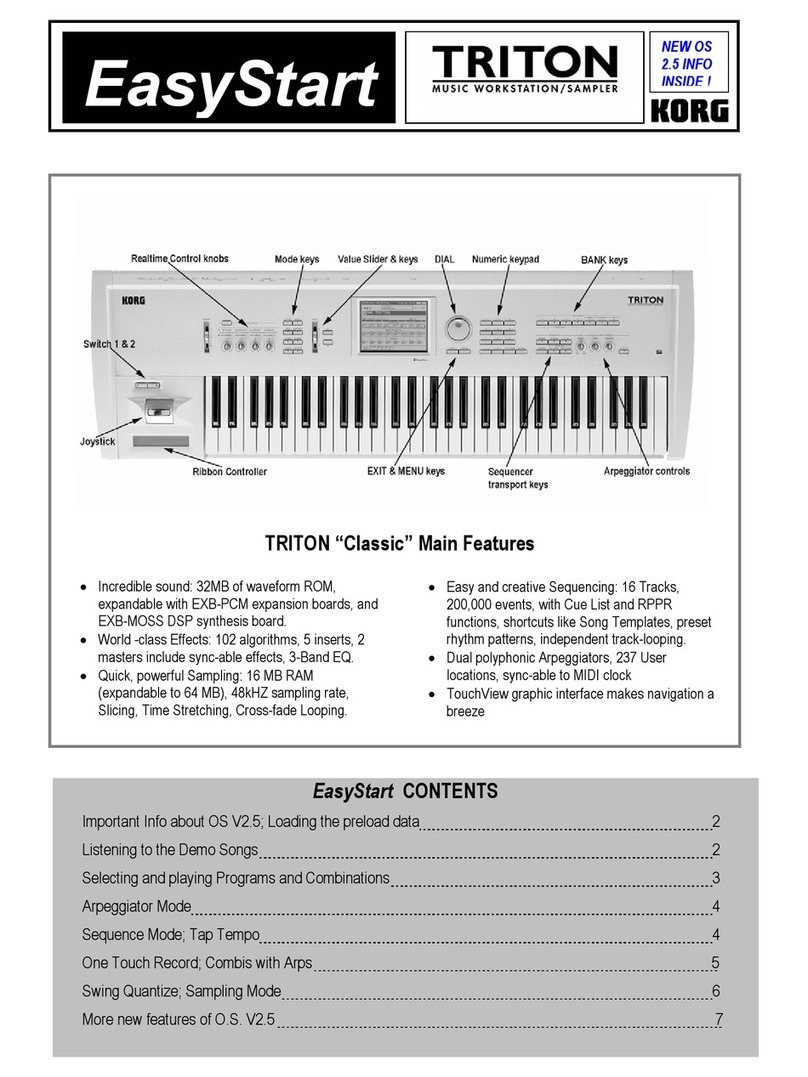Viscount SYNTH-8 User manual

Edition: 1.1
User Manual - EN
Manuale Utente - IT
SYNTH - 8
V I R T U A L A N A L O G


EN - 1
Table of contents
Synth-8 –User Manual
TABLE OF CONTENTS
IMPORTANT NOTES........................................................................................................................2
Product installation...............................................................................................................2
Notes about this manual.......................................................................................................2
INTRODUCTION................................................................................................................................3
Main features........................................................................................................................3
FRONT PANEL..................................................................................................................................4
PARAMETER EDITING.....................................................................................................................6
GENERAL Section ...............................................................................................................7
OSC 1 and OSC 2 sections..................................................................................................9
FILTER section...................................................................................................................10
AMP ENV section...............................................................................................................12
MOD ENV section ..............................................................................................................13
LFO 1 and LFO 2 sections .................................................................................................14
MISCELLANEOUS section.................................................................................................15
ARP section........................................................................................................................16
ASSIGN section..................................................................................................................18
The Synth Presets..............................................................................................................18
MIDI Controller List....................................................................................................... MIDI - 1

EN - 2
Synth-8 –User Manual
Important notes
IMPORTANT NOTES
Product installation
To install the module on the front panel of the Legend '70s, follow the instructions in the
package leaflet or those in the instrument user manual.
Notes about this manual
Keep this manual with care.
This manual is an integral part of the instrument. The descriptions and illustrations
contained in this publication are not binding.
While the instrument’s essential characteristics remain the same, the manufacturer
reserves the right to make any modifications to parts, details or accessories considered
appropriate to improve the product or for requirements of a constructional or commercial
nature, at any time and without undertaking to update this publication immediately.
All rights reserved; the reproduction of any part of this manual, in any form, without the
manufacturer’s specific written permission, is forbidden.
All the trademarks referred to in this manual are the property of the respective
manufacturers.
Please read all the information carefully, so that you obtain the best performance and will
from your instrument.
The codes or numbers in square brackets ([ ]) indicate the names of the buttons, sliders,
trimmers and connectors on the instrument. For example, [ON/OFF] refers to the ON/OFF
button.
The illustrations are purely for information purposes and may differ from your product.
The instructions provided in this manual only concern the instrument's operating system
version that was up to date when the document was released. Therefore, such
instructions might not describe faithfully your current operating system release. Please,
visit the website www.viscountinstruments.com to check for the newest operating system
release and manual.
This user manual is updated to version 1.06 of the instrument's operating system.

EN - 3
Synth-8 –User Manual
Introduction
INTRODUCTION
Main features
Synth-8 is an eight-voice polyphonic synthesizer with "virtual analog" technology, specially
designed for the Legend '70s series pianos. The synth architecture features two oscillators
for each voice and the faithful reproduction of a classic american multimode analog filter with
saturation, available in low-pass, high-pass, band-pass and notch configurations at 12dB and
24dB per octave, with resonance and cutoff frequency controls.
The synth architecture is easy to understand and operate but has unique features: classical
waveforms with waveshaping and detuned doubling of the oscillators with "Fat" modes,
dedicated envelope for the noise, Ring Mod, Hard Sync for all oscillator modes, velocity
controls for filters and envelopes.
The Synth-8 module also offers a dedicated arpeggiator section, capable of cyclically playing
the notes in the desired order, and a 4x16 step sequencer, with the ability to play a pre-
programmed 16-notes sequence tuned with the pressed notes as well as 3 sequences that
can be assigned to the generation parameters.
Finally, the Unison modes allow stacking up to 8 voices: with "Fat" oscillators this makes a
total of 32 detuned oscillators at once!
Most of the sound generation parameters can be adjusted with the module panel controls; it
is possible to choose the parameter to be adjusted, through a matrix selection printed on the
panel, using the four knobs. However, it is possible to freely assign a parameter to each
knob. Through the "Legend'70s Editor" application available for Windows, MacOS and iOS it
is possible to control all the parameters and functions present in the Synth-8 in real time and
make the modification of new patches as simple as having a complete control panel.
Thanks to the simple and intuitive interface of the Legend '70s Editor, the control of Synth-8
will be extremely comfortable and fast. Legend '70s Editor is completely free and can be
downloaded from the website www.viscountinstruments.com.
Synth-8 comes with a large library of factory presets, which can be selected, edited and
stored in the instrument's Programs, along with all other parameters.
Synth-8 Voice Architecture
OSC 1
OSC 2
RING MOD
NOISE
Osc 1 Level
Noise Level
Osc 2 Level
Ring Level FILTER AMP
Volume
MOD ENV AMP ENV
LFO 1 LFO 2
Output
Routing

EN - 4
Synth-8 –User Manual
Front panel
FRONT PANEL
[ON/OFF] button.
Button to switch on/off the sound generated by the module. When the button Led is on,
the module is active and able to receive notes from the keyboard.
[VOLUME] knob.
Adjust the volume of the sound generated by the module.
Status Leds.
These Led lights show the status of several sound generation parameters. When the
Led light is on:
[ ]: the Split function is active (see Common Section, Split Mode parameter, in the
Legend ‘70s User Manual) and the sound is assigned to the Lower part of the
keyboard. You can activate the Split function and assign the sound to the lower
section by pushing [SPLIT] and the module [ON/OFF] button simultaneously. Once
the sound has been assigned, press [SPLIT] and [ON/OFF] (on the module) again, to
assign the sound to the Upper section.
[ ]: the sound is currently transposed (see E.Piano Section, Note Shift parameter,
in the Legend ‘70s User Manual).
[ ]: the module output signal is assigned to the effect FX1 (see E.Piano Section,
Output Routing parameter, in the Legend ‘70s User Manual). To assign an effect,
select the FX1 effect (to do so, press the [FX 1] button under the EFFECTS section)
then, while pressing [FX ON], push the [ON/OFF] button on the module. Once the
effect has been assigned, press [FX ON] and [ON/OFF] again to undo.
[ ]: the module output signal is assigned to the effect FX2 (see E.Piano Section,
Output Routing parameter, in the Legend ‘70s User Manual). To assign an effect,
select the FX2 effect (to do so, press the [FX 2] button under the EFFECTS section)
then, while pressing [FX ON], push the [ON/OFF] button on the module. Once the
effect has been assigned, press [FX ON] and [ON/OFF] again to undo.
[ ]: activation of the arpeggiator / step sequencer. The LED flashes synchronized
with the metronomic tempo set for the arpeggio or the playback of the sequences
(see Arp Section on page. 16).
1
2
3
1
2
3
4
7
6
5

EN - 5
Synth-8 –User Manual
Front panel
[▲] e [▼] / [PRESETS] buttons.
Using these buttons, you can select the group of 4 parameters adjusted by the [ASSIGN
1], [ASSIGN 2], [ASSIGN 3] and [ASSIGN 4] knobs. The adjustable parameters are the
serigraphed ones as indicated in point 6. By pressing these buttons it is possible to
select the row of the table that indicates the parameters currently assigned to the knobs,
the selected row is indicated by the LED on as indicated in point 5.
LEDs for displaying the parameters adjusted by the [ASSIGN] knobs.
These LEDs show the row of the parameter table (see point 6) selected with the [▲] and
[▼] / [PRESETS] buttons and therefore which parameters are currently adjusted by the
[ASSIGN 1], [ASSIGN 2], [ASSIGN 3] and [ASSIGN 4] knobs. For example, when the
first LED at the top left is lit, the parameters adjusted by the 4 knobs are:
-[ASSIGN 1]: Osc1 Shape
-[ASSIGN 2]: Osc1 Coarse
-[ASSIGN 3]: Osc1 Fine
-[ASSIGN 4]: Osc1 Level
Table of parameters that can be adjusted with the [ASSIGN] knobs.
This table lists all the parameters that can be adjusted with the [ASSIGN 1], [ASSIGN 2],
[ASSIGN 3] and [ASSIGN 4] knobs. To select the parameters to be adjusted, refer to
points 4 and 5. For further information on the parameters, refer to the Parameter editing
section on page 6.
Synthesizer parameter adjustment knobs.
Knobs for adjusting the parameters selected with the [▲] and [▼] / [PRESETS] buttons
as shown in point 4 and 5.
4
NB
-Hold down the [▲] button for a while to access all the configuration parameters of the
selected section.
-Hold down the [▼] / [PRESETS] button for a while to access the Preset library (see The
Synth Presets, page 18).
5
NB
-Some rows of the parameter table have two LEDs, as in the case of Osc1-2 (or LFO1-2). In
this case the left Led indicates that it refers to the Osc1 (or LFO1) parameters, while the
right Led refers to the Osc2 (or LFO2) parameters.
-If none of the display LEDs are lit, the [ASSIGN 1], [ASSIGN 2], [ASSIGN 3], [ASSIGN 4]
knobs adjust the parameters assigned in the current Program (see Assign Section on page
18).
6
7

EN - 6
Synth-8 –User Manual
Parameter editing
PARAMETER EDITING
Menu name.
Indicates that you are in the main page of the EDIT SYNTH-8 menu.
Page number.
Shows the current page of the menu (for example “1/3” means that the current page is
the first of the three
available pages).
Program section list.
Press the button [<] or [>] or rotate the data entry dial to move the cursor on the desired
Program section.
Then press the data entry dial to access that section and its parameters. Available
sections are:
Section
Description
GENERAL
General parameters of the Synth-8
OSC.1
Oscillator 1 configuration parameters
OSC.2
Oscillator 2 configuration parameters
FILTER
Filter configuration parameters
AMP ENV
Amplitude envelope configuration parameters
MOD ENV
Modulation envelope configuration parameters
LFO 1
LFO 1 configuration parameters
LFO 2
LFO 2 configuration parameters
MISC
Miscellaneous (Voice Mode, Port Time, Ring Level, Noise Level, etc..)
configuration parameters
ARP
Arpeggiator / Step sequencer configuration parameters
ASSIGN
Custom assignment of parameters to the [ASSIGN] knobs
Press [EXIT] or [EDIT] / [STORE] to return to the main Program Mode screen.
With the instrument in Program mode, press the
[EDIT] button to access the EDIT PROGRAM
menu.
In the
EDIT PROGRAM
screen, place the cursor
on the
SYNTH-8
field and press the dial data
entry. The main menu is displayed to access the
programming sections of the Synth-8.
1
2
3
NB
For how to store a Program, consult the Legend ‘70s user manual.
1
3
2

EN - 7
Synth-8 –User Manual
Parameter editing
GENERAL Section
The GENERAL menu contains the general parameters of
the Synth-8 which determine the operation of all the
sections it consists of.
To access this menu, place the cursor on the GENERAL
field in the EDIT SYNTH-8 screen (page 6) and press the
data entry dial.
Parameter name
Description
Switch
[ON/OFF]
Activate / deactivate the module.
Values: OFF, ON
Volume
[VOLUME]
Level of the module generated signal.
Values: between 0 and 127
Output Routing
Assign the module audio output.
Values:
Main L-R: AUDIO OUT [MAIN L/MONO] and [MAIN R] connectors on the
rear panel (stereo signal)
FX1: input of the EFFECTS section FX1
FX2: input of the EFFECTS section FX2
FX1+FX2: inputs of both FX1 and FX2 of the EFFECTS section
Aux1 Mono: AUDIO OUT [AUX 1] connector on the rear panel (mono signal)
Aux2 Mono: AUDIO OUT [AUX 2] connector on the rear panel (mono signal)
Aux1-2: AUDIO OUT [AUX 1] and [AUX 2] connectors on the rear panel
(stereo signal)
Reverb Send
Level of the audio signal generated by the module and sent to the Reverb
effect.
Values: between 0 and 127
NB
This parameter only works if the audio output selected through the Output
Routing parameter is MAIN L-R
Detune
Tuning of the sound generated by the module, expressed in hundredths of
semitone (or cent).
Values: between -50 and +50 semitone cents
Note Shift
Module sound transposition (in semitones).
Values: between -48 and +48 half-tones
NB
When transposition is applied, the [ ] module Led is on.
FX1
Reverb Master
EQ MAIN
L-R
AUX1
AUX2
Output
Routing
Sound
Module FX2
FX Out
Routing
FX Out
Routing
depends on FX Config

EN - 8
Synth-8 –User Manual
Parameter editing
Velocity Sens
Sensitivity of the signal level to the pressure exerted on the keyboard (velocity).
When a certain pressure is applied the signal level is increased (positive
values) or decreased
(negative values)
Values: between -5 and +5
NB
The graph above refers to the Normal velocity curve (see Keyboard Section
of the Legend '70s user manual)
The Velocity Sens parameter has no effect with the Fixed velocity curve (see
Keyboard Section of the Legend '70s user manual)
Alt. Keyb
Enable the Alternative-Keyboard mode for this module (see Controlling
Legend ‘70s with an
external keyboard section on the Legend ‘70s User Manual)
Values: OFF, ON
NB
When Alternative-Keyboard mode is enabled, the [ ] module led flashes
Pitch Bend
Enable the Pitch Bend wheel for this module (see Wheels section on the
Legend ‘70s User Manual)
Values: OFF, ON
Mod.Wheel
Enable the Modulation wheel for this module (see Wheels section on the
Legend ‘70s User Manual)
Values: OFF, ON
NB
The function associated to the modulation wheel is determined by the
COMMON menu, parameter Mod.Wheel Dest (see Common Section on the
Legend ‘70s User Manual) and affects all modules
Sustain Pedal
Enable the Sustain pedal (connected to the [SUSTAIN] connector on the rear
panel) for this module
Values: OFF, ON
Foot Switch1
Foot Switch2
Foot Control1
Foot Control2
Enable the pedals connected to the connectors PEDAL [FOOT SWITCH 1],
[FOOT SWITCH 2], [FOOT CONTROLLER 1] and [FOOT CONTROLLER 2]
(rear panel) for this module.
Values: OFF, ON
NB
The function assigned to these pedals is defined by the section COMMON,
parameters FS1 Dest, FS2 Dest, FC1 Dest, FC2 Dest (see Common Section
on the Legend ‘70s User Manual) and the setting affects all modules.
The parameters Foot Switch 1 and Foot Switch 2 also enable (respectively)
the left and central pedal of a triple pedal connected to the PEDAL
[SUSTAIN] connector.
Signal
level
Key
velocity
Velocity
Sens = -5
Velocity
Sens = 0
Velocity
Sens = +5
12764
64
127

EN - 9
Synth-8 –User Manual
Parameter editing
OSC 1 and OSC 2 sections
The Synth-8 has two oscillators per voice, each capable of
generating different waveforms. The SYNTH OSC1 and
SYNTH OSC2 menus contain the adjustment parameters
of the first and second oscillator respectively. These
parameters are common for both oscillators and are
described in the table below.
To access these menus, in the EDIT SYNTH-8 screen
(page 6) place the cursor on the OSC 1 or OSC 2 fields
and press the dial data entry.
Parameter name
Description
Osc1 Shape
Osc2 Shape
[ASSIGN 1]
Selection of the oscillator waveform.
Values:
Sawtooth: sawtooth wave.
Alt Saw 1, Alt Saw 2: variants of the sawtooth waveform,
based on phase shift with two different effect settings.
Fat Saw 1, Fat Saw 2: double sawtooth wave, with two
different detuning levels.
Triangle: triangular wave.
Alt Triangle 1, Alt Triangle 2: variants of the triangular
waveform, based on the shift of the phase with two different
effect settings.
Fat Triangle 1, Fat Triangle 2: double triangular wave, with
two different levels of detuning.
Pulse: pulse wave, with duty cycle at 50%.
Pulse 60, Pulse 80, Pulse 95: pulse wave, with duty cycle at
60%, 80%, 95%.
Fat Pulse 1, Fat Pulse 2: double pulse wave, with two different
detuning levels.
Osc1 Coarse
Osc2 Coarse
[ASSIGN 2]
Tuning of the oscillator in semitones.
Values: -24 to +24 semitones
Osc1 Fine
Osc2 Fine
[ASSIGN 3]
Fine tuning of the oscillator in cents of a semitone.
Values: from -50 to +50 cents of a semitone
Osc1 Level
Osc2 Level
[ASSIGN 4]
Signal level generated by the oscillator.
Values: between 0 and 127
NB
The table below shows all the parameters available for the OSC 1 and OSC 2 sections. The knob
or button that allows direct control from the panel is shown under the name of the parameter.

EN - 10
Synth-8 –User Manual
Parameter editing
Osc1 Keytrack
Osc2 Keytrack
Keyboard tracking on/off. When the function is enabled, the pitch of the
oscillator varies according to which key is pressed: in this case, each key
corresponds to a note. By disabling this function, the frequency of the signal
generated by the oscillator is always fixed regardless of the key pressed and
established with the Osc1 Coarse (or Osc2 Coarse) and Osc1 Fine (or Osc2
Fine) parameters.
Values: OFF, ON
Osc2 Sync
(OSC.2 only)
Activation / deactivation of the
synchronization of Osc 2 with Osc 1. If
synchronized, every time the waveform of
Osc 1 returns to its beginning, that of Osc
2 will also be reset (i.e. to the beginning of
its cycle) obtaining thus a more complex
waveform.
Values:OFF, ON
FILTER section
Synth-8 features low-pass, band-pass, high-pass and notch
filters, with slope at 12 dB or 24 dB per octave (6 dB and 12
dB for band-pass and Notch filters), with adjustable
frequency, resonance, distortion and other parameters. The
filter frequency can be modulated via the key velocity and/or
the AD envelope of the MOD ENV section (page 13).
To access this menu, in the EDIT SYNTH-8 screen (page
6), place the cursor on the FILTER field and press the data
entry dial.
Parameter name
Description
Filter Cutoff
[ASSIGN 1]
Filter cutoff frequency. Depending on the filter
type, the cutoff frequency takes on different
meanings; refer to the description of the Filter
Type parameter regarding the effectiveness of
the filter in relation to the cutoff frequency.
Values: between 0 and 127
Filter Reso
[ASSIGN 2]
Resonance coefficient. The resonance causes an enhancement of the
frequencies around the cutoff frequency. By increasing the resonance, a
greater selectivity of the frequencies that are affected by the enhancement
is obtained.
Values: between 0 and 127
Level
Freq.
Filter Resonance
Filter
Cutoff
Level
Freq.
Filter
Cutoff
Level
Freq.
Filter
Cutoff
NB
The table below shows all the parameters available for the FILTER section. The knob or button
that allows direct control from the panel is shown under the name of the parameter.
Level
Frequency
Filter Cutoff
Osc 1
Osc 2
(synchronized)

EN - 11
Synth-8 –User Manual
Parameter editing
Filter Type
[ASSIGN 3]
Filter type.
Values:
LP 12 dB: low-pass filter with a slope of 12 dB/oct
which progressively attenuates the frequencies
above the cutoff one, thus giving a darker and/or
softer tone to the sound.
LP 24 dB: like LP 12 dB but with a slope of 24
dB/oct which attenuates in a more incisive way the
frequencies above than the cutoff one.
BP 6 dB: band-pass filter with 6 dB/oct slope that
progressively attenuates out-of-band frequencies,
whose center corresponds to the cutoff frequency.
BP 12 dB: like BP 6 dB but with a slope of 12 dB/oct
which attenuates the frequencies around the cutoff
to a greater extent.
HP 12 dB: high-pass filter with 12 dB/oct slope that
progressively attenuates the frequencies below the
cutoff one, the resulting sound will be sharper and
brighter.
HP 24 dB: like HP 12 dB but with a slope of 24
dB/oct which attenuates in a more incisive way the
frequencies below the cutoff one.
Notch 6 dB: Notch filter with 6 dB/oct slope that
attenuates frequencies around the cutoff point.
Frequencies below or above the cutoff point are
passed through.
Notch 12 dB: like Notch 6 dB but with a slope of 12
dB/oct which attenuates in a less incisive way the
frequencies around the cutoff.
Filter Drive
[ASSIGN 4]
Amount of signal distortion. Synth-8 allows you to apply the distortion effect
to the output signal of the filter in order to obtain even more ringing and
metallic sounds.
Values: between 0 and 127
Filter Keytrack
Keyboard tracking amount. According to the
laws of acoustics, if the pitch of a waveform is
raised, the harmonics naturally rise in frequency.
If the cutoff frequency of the filter is constant, the
sound will be perceived more “dull” on the higher
notes of the keyboard. To avoid this effect, the
Filter Keytrack is used. In the case of a low-pass
filter, values close to 0 ensure that the cutoff
frequency remains fixed for the entire extension of the keyboard, obtaining
the effect described above. By adjusting the parameter with positive values,
the cutoff frequency rises in the higher notes, which are therefore brighter
while the lower notes will be darker. On the contrary, by setting the
parameter with negative values, the cutoff frequency decreases with the
higher notes that will have even less harmonics than the parameter set at 0,
while the lower notes will be richer in harmonics.
Values: between -64 and +63.
Filter Vel. Amt
Modulation amount of the filter cutoff frequency, controlled by keyboard
velocity. At high parameter values the filter cutoff frequency is raised as you
play harder.
Values: between 0 and 127
Level
Freq.
Filter
Cutoff
12dB/Oct
24dB/Oct
Level
Freq.
Filter
Cutoff
6dB/Oct
12dB/Oct
Level
Freq.
Filter
Cutoff
12dB/Oct
24dB/Oct
Freq. (octave)
Note
C2 C6C4
0
-2
+2
Keyboard Tracking=0
Keyboard Tracking=+63
Keyboard Tracking=-64
Level
Freq.
Filter
Cutoff
6dB/Oct
12dB/Oct

EN - 12
Synth-8 –User Manual
Parameter editing
AMP ENV section
With this section it is possible to adjust the temporal
evolution of the sound amplitude. The amplitude envelope
applicable to the Synth-8 is the classic ADSR, which is
made up of four phases over time: Attack, Decay, Sustain,
Release.
To access this menu, in the EDIT SYNTH-8 screen (page 6), place the cursor on the AMP
ENV field and press the data entry dial.
Parameter name
Description
Amp Attack
[ASSIGN 1]
Time taken for the signal to reach its maximum level after a key is pressed.
Values: between 0 and 127
Amp Decay
[ASSIGN 2]
Time required to reach the Sustain level after the maximum level has been
reached.
Values: between 0 and 127
Amp Sustain
[ASSIGN 3]
Sustain level, that is the level of the signal reached after the Decay phase.
Values: between 0 and 127
Amp Release
[ASSIGN 4]
Time required for the signal level to reach zero after the key is released.
Values: between 0 and 127
Amp VelAmt
Modulation amount of the amplitude envelope controlled by the key velocity. At
high parameter values, the signal level is increased as you play harder.
Values: between 0 and 127
NB
The table below shows all the parameters available for the AMP ENV section. The knob or button
that allows direct control from the panel is shown under the name of the parameter.
Attack
Time
Level
Time
Decay
Time Release
Time
Sustain
Level
key down key up

EN - 13
Synth-8 –User Manual
Parameter editing
MOD ENV section
The modulation envelope is a simple three-phase ADR
envelope (Attack, Decay, Release) with which to modulate
the filter frequency and/or the pitch of the oscillators over
the time.
To access this menu, in the EDIT SYNTH-8 screen (page 6), place the cursor on the MOD
ENV field and press the data entry dial.
Parameter name
Description
Mod Attack
[ASSIGN 1]
Time taken by the envelope to reach its maximum level, and therefore the
maximum variation of the filter cutoff frequency and/or the pitch of the
oscillators, after a key is pressed.
Values: between 0 and 127
Mod Decay
[ASSIGN 2]
Time taken by the envelope, after it has reached the maximum level, to
return to the initial level, and then to the basic cutoff frequency of the filter
and/or the basic pitch of the oscillators.
Values: between 0 and 127
NB
When the Decay value is 127 the envelope does not decay but remains at
the maximum level until the note is released.
The Release phase of the MOD envelope is calculated with the same
value as that of Decay.
Mod Filter Amt
[ASSIGN 3]
Modulation amount of the filter cutoff frequency controlled by the envelope.
At positive values, the filter frequency is increased based on the
development over time of the envelope. At negative values, the frequency is
lowered following the envelope.
Values: between -64 and +63
Mod Pitch Amt
[ASSIGN 4]
Modulation amount of the pitch of the oscillators controlled by the envelope.
At positive values, the pitch is raised according to the development of the
envelope. At negative values, the pitch is lowered following the envelope.
Values: between -64 and +63
Mod Vel. Amt
Amount of envelope modulation controlled by the key velocity. At high parameter
values, the envelope level is increased or lowered (based on the values of the
Mod Filter Amt and Mod Pitch Amt parameters) when you playlouder.
Values: between 0 and 127
NB
The table below shows all the parameters available for the MOD ENV section. The knob or button
that allows direct control from the panel is shown under the name of the parameter.
Attack
Time
Amount
Time
Decay
Time Release
Time
key down key up

EN - 14
Synth-8 –User Manual
Parameter editing
Mod Pitch Dest
Selection of the oscillator whose pitch must be controlled by the envelope.
Values:
Osc1+2 Pitch: the envelope controls the pitch of both oscillators.
Osc1 Pitch: the envelope controls the pitch of oscillator 1 only.
Osc2 Pitch: the envelope controls the pitch of oscillator 2 only. This is
particularly useful to dynamically change the timbre of Osc2 when the
Osc2 Sync mode is active.
LFO 1 and LFO 2 sections
Synth-8 allows you to adjust many parameters such as the frequency of the modulating
signal, to choose its waveform, to adjust the modulation depth, to establish synchronization
with the instrument's master clock and more. The SYNTH LFO 1 and SYNTH LFO 2 menus
contain the adjustment parameters for the first and second LFOs respectively. These
parameters are common for both oscillators and are described in common in the table below.
To access this menu, in the EDIT SYNTH-8 screen (page 6), place the cursor on the LFO 1
or LFO 2 field and press the data entry dial.
Parameter name
Description
LFO1 Shape
LFO2 Shape
[ASSIGN 1]
Waveform selection.
Values:
OFF: no waveform generated (LFO disabled).
Triangle: triangular waveform.
Sine: sine waveform.
Sawtooth: sawtooth waveform.
Rev Saw: inverted sawtooth waveform.
Square: square waveform.
Vintage Sine: variant of the Sine with more squared half-
wave peaks.
Parabola: waveform obtained from parabolic sections.
Random: waveform with a sequence of slightly filtered
random values.
Step Random: waveform with a sequence of random values.
LFO1 Rate
LFO2 Rate
[ASSIGN 2]
Frequency of the signal generated by the LFO (modulation frequency applied
to the destination, see LFO1 Dest or LFO2 Dest parameter).
Values: between 0 and 127
LFO1 Amount
LFO2 Amount
[ASSIGN 3]
Level of the signal generated by the LFO (modulation depth applied to the
destination, see LFO1 Dest or LFO2 Dest parameter).
Values: between 0 and 127
NB
The table below shows all the parameters available for the LFO 1 and LFO 2 sections. The knob
or button that allows direct control from the panel is shown under the name of the parameter.

EN - 15
Synth-8 –User Manual
Parameter editing
LFO1 Dest
LFO2 Dest
[ASSIGN 4]
Select the destination of the LFO signal.
Values:
Osc1+2 Pitch: the LFO modulates the pitch of both oscillators.
Osc1 Pitch: the LFO modulates the pitch of oscillator 1 only.
Osc2 Pitch: the LFO modulates the pitch of oscillator 2 only.
Noise Level: the LFO modulates the noise source level (see p. 16).
Filter Cutoff: the LFO modulates the filter cutoff frequency.
Amp Level: the LFO modulates the amplitude level of the signal.
Pulse Width: the LFO modulates the duty cycle when an oscillator
generates the Pulse wave.
LFO1 Modulation
LFO2 Modulation
Additional modulation depth given by the Modulation parameter assignable to
the control of Mod.Wheel or Foot Controller 1/2.
Values: between 0 and 127
LFO1 Delay
LFO2 Delay
Delay to reach the maximum level of the signal generated by the LFO and the
maximum modulation of the destination (see parameter LFO1 Dest or LFO2
Dest) after the key has been pressed.
Values: between 0 and 127
LFO1 Sync
LFO2 Sync
Synchronization of the LFO with the general metronomic tempo of the
instrument set in the COMMON menu with the Master Clock parameter (see
COMMON section of the Legend '70s user manual).
Values: OFF, ON
MISCELLANEOUS section
The Miscellanous section collects various configuration
and generation parameters, such as the voice mode to
choose whether to play polyphonic, monophonic or legato
and with glissato, the adjustment of the amount of ring
modulation with which to obtain more metallic sounds, the
addition of a noise signal to obtain special percussive
effects and more.
To access this menu, in the EDIT SYNTH-8 screen (page
6), place the cursor on the LFO 1 or LFO 2 field and press the data entry dial.
Parameter name
Description
Voice Mode
[ASSIGN 1]
How to play the voice.
Values:
Poly: polyphonic mode, with which it is possible to play several notes at the
same time (up to a maximum of 8).
Mono: monophonic mode, with which it is possible to play only one note at a
time. By pressing a key, then a second key without releasing the first, the last
note is played. Releasing the second key returns to playing the first note. This
mode reproduces the behavior of traditional monophonic analog synthesizers
and is used in the performance of solo sounds.
Legato: legato mode, similar to Mono but which allows you to play
successive notes without interruption, i.e. without retriggering the amplitude
and modulation envelope.
NB
The table below shows all the parameters available for the MISCELLANEOUS section. The knob
or button that allows direct control from the panel is shown under the name of the parameter.

EN - 16
Synth-8 –User Manual
Parameter editing
Unison Mode
Unison mode selection.
Values:
OFF: Unison mode disabled.
Unison2 Det 1, Unison2 Det 2, Unison4 Det 1, Unison4 Det 2, Unison8
Det 1, Unison8 Det 2: Unison mode with which, for each note, 2 (Unison2), 4
(Unison4) or 8 (Unison8) voices are generated that are the same but slightly
detuned, where Det2 has a detuning level higher than Det1. It should be
noted that the Unison mode affects the polyphony available to the instrument,
so, for example, with Unison2 the maximum polyphony is reduced to 4 notes.
Unison2 LR, Unison4 LR, Unison8 LR: as for the previous mode, but with
the difference that each detuned voice is distributed on the single Left or
Right audio output. It is suggested to use both [L/MONO] and [R] outputs, or
to use the headphones out when using this mode.
Port Time
[ASSIGN 2]
Portamento Time (Glissato). With the Portamento function, which can only be
used with the Mono and Legato voice modes, it is possible to make smooth
pitch changes between one note and the next with adjustable time. Portamento
time sets the time to reach the frequency of the next note.
Values: between 0 and 127
Ring Level
[ASSIGN 3]
Ring Modulation Level. Ring Modulation is a type of
modulation that multiplies two signals, in the case of the
Synth-8 the one coming from the first oscillator with the
one generated by the second. The resulting sound is
characterized by many harmonic and inharmonic
partials, not present in the harmonic spectrum of the
original signals, making the sound metallic, dissonant
and almost out of tune.
Values: OFF, between 0 and 127
Noise Level
[ASSIGN 4]
Level of the noise source.
Values: between 0 and 127
Noise Decay
Noise decay time, i.e. the time required for the noise level to reach zero, after
pressing the key.
Values: between 0 and 127
Noise Type
Noise type.
Values:
White Noise: is a broadband non-periodic signal that contains all frequencies
of the audible spectrum, With this a "hiss" can be added to the signal, which
is useful to simulate the sound of instruments producing noise such as winds
and whistles.
Pink Noise: It is a particular type of noise that decreases in intensity with
increasing frequency.
P.Bend Range
Pitch Bend wheel range. Determines the maximum extension, in semitones, of
the Pitch Bend wheel for both directions.
Values: between 1 and 12.
ARP section
The Arpeggiator section allows you to perform arpeggios
by composing a chord on the keyboard or by pressing a
single note and arpeggiating the same by octave. It is
possible to adjust the direction of the arpeggio, the
playback speed, the extension by octaves and other
parameters.
The Arpeggiator section of the Synth-8 can also operate in
Osc 1
Osc 2
Resulting
waveform

EN - 17
Synth-8 –User Manual
Parameter editing
Step Sequencer mode, capable of playing back sequences of notes and controls by pressing
a key on the keyboard. The sequence will start with the note pressed to continue with the
preprogrammed pattern. The Step Sequencer mode provides 40 preprogrammed patterns
and 8 user-programmable patterns, which can be edited using the Legend '70s Editor
application.
To access this menu, in the EDIT SYNTH-8 screen (page 6), place the cursor on the LFO 1
or LFO 2 field and press the data entry dial.
Parameter name
Description
Arp Switch
[ASSIGN 1]
Activation / deactivation of the Arpeggiator or Step Sequencer function.
Values: OFF, ON
Arp Tempo
[ASSIGN 2]
Arpeggio or sequence playback time.
Values: between 40 and 148x8 bpm
Arp Hold
[ASSIGN 3]
Activation / deactivation of the Hold function that allows you to keep the
playback of the arpeggiated notes or the sequence even by releasing the keys.
The subsequent notes played will replace the previous ones in the arpeggio
phase or will start the sequence starting from the new note.
Values: OFF, ON
Arp Mode
[ASSIGN 4]
Values:
Up: arpeggio from the lowest to the highest note.
Down: arpeggio from the highest to the lowest note.
Up+Down: arpeggio from the lowest note to the highest and then return to
the lowest note.
Random: random arpeggio.
Up 2: like Up but on two octaves.
Down 2: like Down but on two octaves.
Up+Down 2: like Up+Down but on two octaves.
Random 2: like Random but on two octaves.
Up 3: like Up but on three octaves.
Down 3: like Down but on three octaves.
Up+Down 3: like Up+Down but on three octaves.
Random 3: like Random but on three octaves.
Step Seq 1…50: selection of the pre-programmed sequences of the Step
Sequencer. The Step Sequencer allows you to play sequences of notes
starting from the one played according to a pre-programmed rhythmic pattern,
with the continuous modification of some controls (filter frequency, oscillator
level, modulation change, etc.).
User Seq1…8: selection of the sequences programmed by the user of the
Step Sequencer. Programming of the 8 sequences can be done using the
Legend '70s Editor application.
Arp Restart
When activated (ON) each new note played on the keyboard restarts the
arpeggio or sequence from the beginning. If it is deactivated (OFF) the
sequence will continue from the point in which it is when the new note is
pressed.
Values: OFF, ON
NB
The table below shows all the parameters available for the ARP section. The knob or button that
allows direct control from the panel is shown under the name of the parameter.

EN - 18
Synth-8 –User Manual
Parameter editing
ASSIGN section
The Assign section allows you to assign any of the Synth-8
module generation parameters to the four controls
[ASSIGN 1], [ASSIGN 2], [ASSIGN 3] and [ASSIGN 4].
As seen on page 6 in fact, these knobs adjust the
parameters based on the selection of the row of the table
printed on the panel. However, if no row in the table is
selected, the 4 adjustment knobs will control the assigned
parameters, thus ensuring convenient and quick access to
the most useful parameters for each Program.
To access this menu, in the EDIT SYNTH-8 screen (page 6), place the cursor on the LFO 1
or LFO 2 field and press the data entry dial.
Parameter name
Description
Assign 1
Assigning the parameter to the knob [ASSIGN 1]
Values: all the parameters present in the SYNTH-8 menus.
Assign 2
Assigning the parameter to the knob [ASSIGN 2]
Values: all the parameters present in the SYNTH-8 menus.
Assign 3
Assigning the parameter to the knob [ASSIGN 3]
Values: all the parameters present in the SYNTH-8 menus.
Assign 4
Assigning the parameter to the knob [ASSIGN 4]
Values: all the parameters present in the SYNTH-8 menus.
The Synth Presets
Synth-8 provides 128 preset sounds to be used
immediately or from which to start your own programming
and configuration of a sound. When storing the Program, it
will contain the parameters of the selected or modified
Preset, although, when viewing the SYNTH-8 PRESETS
screen, it will always show the last Preset selected,
regardless of the one present at the time of storing the
Program.
To access the Synth Preset library, hold down the [▼] / [PRESETS] button for a while; the
screen shown on the side will be displayed. To select the Preset use the dial data entry: by
playing on the keyboard it will be possible to listen to the selected Preset. To confirm the
selection, press the dial data entry or the [▼] / [PRESETS] button. To cancel the selection,
press [EXIT].
Table of contents
Languages:
Other Viscount Synthesizer manuals
